
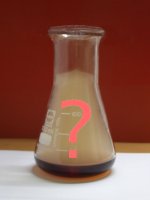

Riddle: Halogens and nitrites
This experiment shows formation of a few remarkable volatile compounds, when nitrite reacts with chloride or bromide in acidic medium. The compounds formed are strongly colored and their appearance depends on the concentration of the acid.
When a solid nitrite is added to an acid, then the reaction, as documented in literature, is the formation of nitrous acid, HNO2. Nitrous acid looses water and then forms N2O3. Another part disproportionates to HNO3 and NO, possibly by decomposition of N2O3 in NO and NO2, where the NO2 in turn reacts with water to form HNO3 and NO. The compound N2O3 is blue and indeed this color can be observed when a nitrite is added to some dilute acid. There also is bubbling of NO, which on contact with air forms brown NO2. When the reaction is carried out in a closed vessel, then finally the liquid becomes colorless or pale blue, with only a colorless gas mixture above it. Any NO2, formed on contact with air, will dissolve in the water and react with this, leaving a colorless liquid and a colorless gas mixture above the liquid.
The reaction, observed here, however looks quite different. No pale blue color of dilute N2O3 is observed, but a bright orange color, when nitrite is reacting with an acid with a high concentration of chloride. A dark brown color is observed when bromide is present at sufficiently high concentration. Besides this, colored gas mixtures are obtained, which remain colored, also when the reaction vessel is kept stoppered for a long time.
![]()
![]() Required
chemicals:
Required
chemicals:
-
concentrated hydrochloric acid (at least 30% HCl)
- dilute hydrochloric acid (approximately 10% HCl)
- potassium bromide
- sodium nitrite
- hydrogen peroxide (approximately 5%)
![]() Required
equipment:
Required
equipment:
-
test tubes
-
rubber stoppers
![]() Safety:
Safety:
-
In this experiment a small amount of NO and NO2 is prepared. These gases are insidiously toxic. Breathing these gases only results in minor direct irritation or suffocation. The real effect is delayed by several hours. Because of the low warning level, absolute care must be taken not to inhale any of these gases. The amounts produced in this experiment are quite small, but in order to be on the safe side it is recommended to perform this experiment only in a good fume hood or outside!
- Hydrochloric acid is corrosive.
- Concentrated hydrochloric acid fumes in air. The fume is very irritating and should not be inhaled.
- In this experiment some bromine is prepared. Bromine is toxic and corrosive. Its vapor is very irritating and should not be inhaled.
- Sodium nitrite is toxic and may irritate the skin. In contact with acids, the gases NO and/or NO2 are released.
![]() Disposal:
Disposal:
-
The chemicals, used in this experiment, can be flushed down the drain with a large amount of water.
![]()
Nitrite and hydrochloric acid of different concentrations
In this first experiment, solid sodium nitrite is added to hydrochloric acid. When the solid is added to concentrated hydrochloric acid (30% HCl), then the reaction is totally different from when it is added to dilute hydrochloric acid (10% HCl). When the solid is added to concentrated hydrochloric acid, then an orange compound is formed, which goes in solution. Besides this, a brown/yellow gas is formed, which does not disappear, when the test tube is stoppered and allowed to stand with exclusion of air. When the solid is added to dilute hydrochloric acid, then a bluish compound is formed and the liquid starts to bubble. In the experiment the liquid is bluish/green. This bluish/green color probably is due to formation of blue N2O3, mixed with small amounts of the orange compound, which is formed when more concentrated acid is used.
The left picture below shows two test tubes. The left one is filled with concentrated hydrochloric acid, to which a spatula full of solid sodium nitrite is added. The right one is filled with dilute hydrochloric acid, to which a spatula full of solid sodium nitrite is added. In the left test tube a white precipitate can be observed. This most likely will be plain salt, NaCl, which is only sparingly soluble in concentrated hydrochloric acid. When sodium nitrite is added to concentrated hydrochloric acid, then at first the liquid becomes turbid and orange/yellow. Only after a few tens of minutes of standing, it becomes clear and orange, as shown on the right picture below.
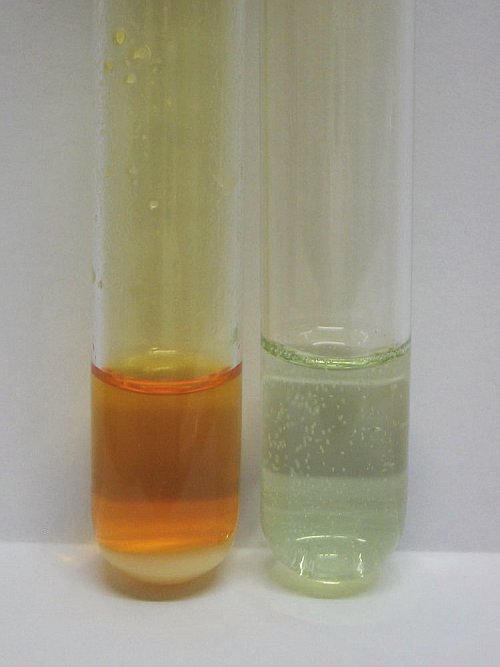
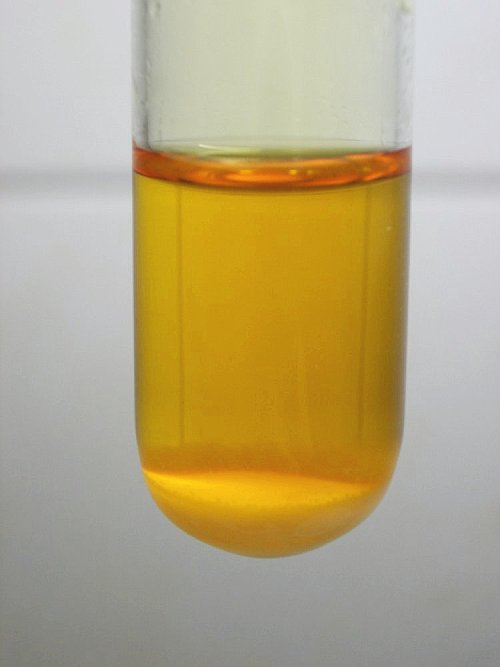
The left test tube also shows the presence of a yellow/brown gas, which does not disappear on shaking, when the test tube is stoppered. The right test tube has a pale brown gas mixture initially, but when it is stoppered and shaken for a while, then the gas mixture becomes colorless.
![]()
Mixture of conc. hydrochloric acid, nitrite and bromide
In the next step of this experiment, solid potassium bromide is added to the test tube with the orange mixture in concentrated hydrochloric acid.
When the bromide is added to the test tube with the orange contents, then at first glance nothing happens. On shaking, however, the bromide (at least partly) dissolves and the color changes from bright orange to deep orange red. The color of the gas mixture becomes reddish brown. This may be due to the color of bromine vapor. The two pictures below show the contents of the test tube. The left picture is taken with light from the front and the right picture is taken with transmitted light. These pictures show that the liquid is dark red/brown. Much darker than one would expect, when only bromine were present.
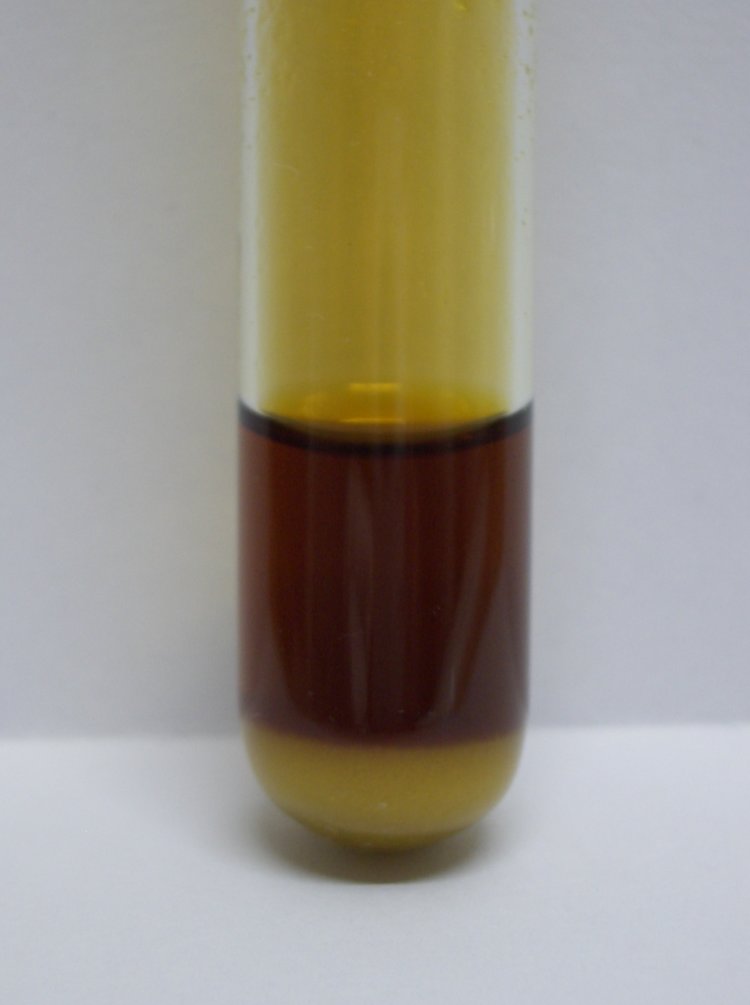
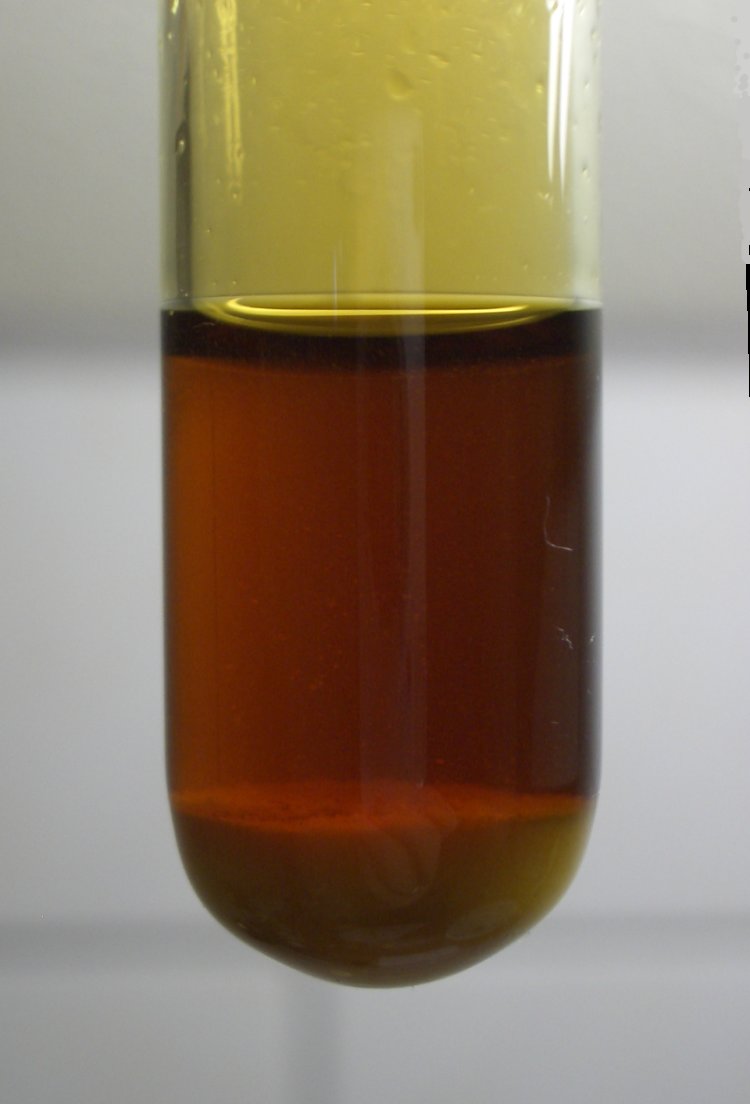
![]()
Mixture of conc. hydrochloric acid, nitrite and bromide
When the bromide is added to the test tube with the bluish green contents, the one with dilute concentrated hydrochloric acid, then a fairly strong effervescence can be observed at the crystals of the potassium bromide. The gas mixture above the liquid becomes brown and remains brown when the test tube is stoppered. The left picture shows the test tube, just a short time after adding the potassium bromide. The middle picture shows the same test tube, two minutes later. Still there is some effervescence and this picture shows a dark brown liquid layer at the bottom of the test tube, which covers the remaining crystals of potassium bromide. This brown layer is not bromine. The border between the two layers is not sharp. Probably this is a very concentrated solution of bromide, which contains much of the reaction product between the acidified nitrite and bromide. The right picture shows the same test tube, after shaking. The dark brown compound of the bottom spreads through the liquid and the remaining crystals of solid potassium bromide also dissolve. The resulting liquid is clear and fairly dark brown.
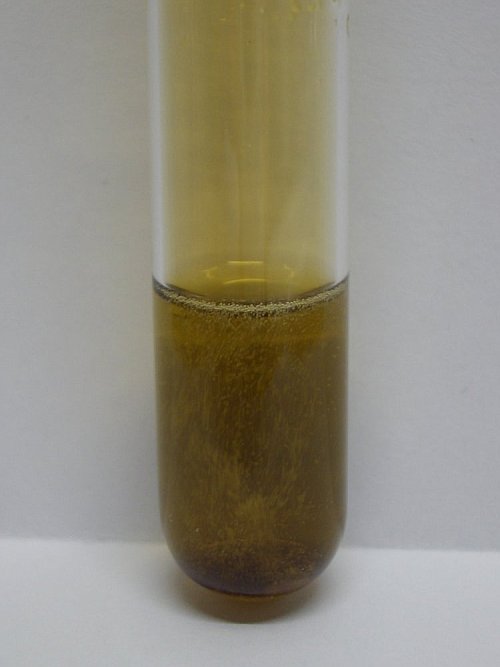
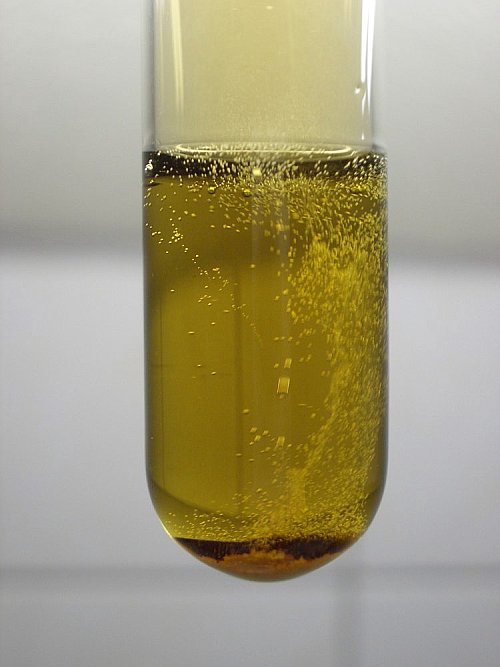
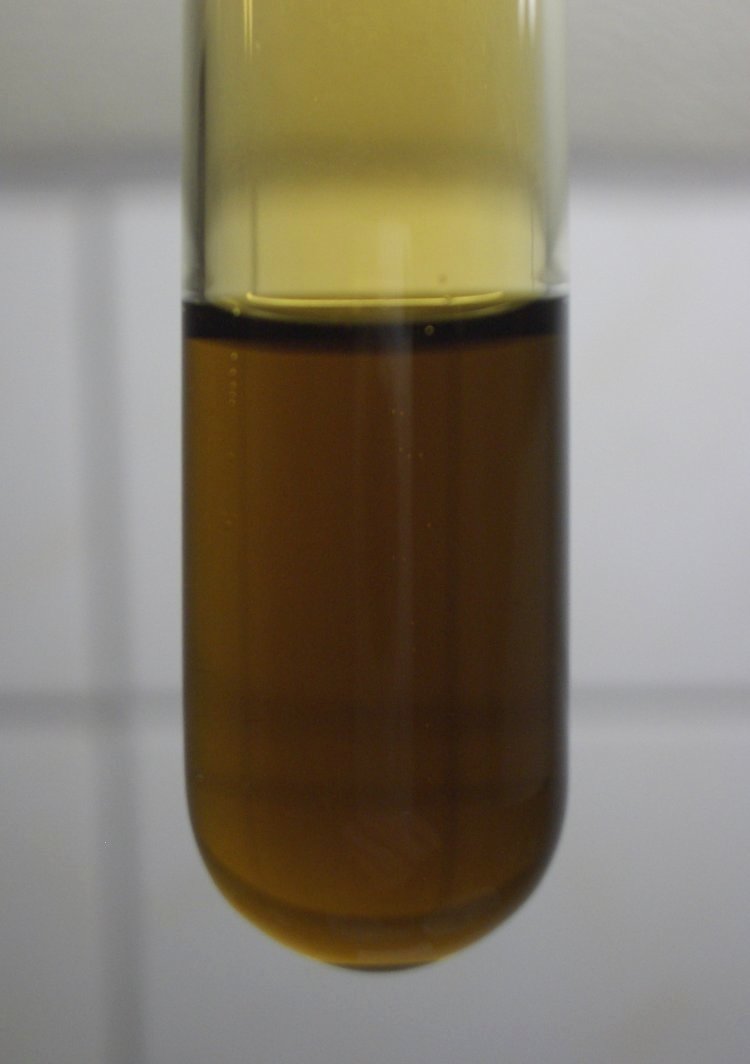
![]()
Dilute vs. concentrated hydrochloric acid with nitrite and bromide
Addition of bromide and nitrite to concentrated hydrochloric acid also results in quite different products, when the concentration of the acid is varied. The experiments, described above, show this very well. Here the final products of both experiments are shown next to each other, such that it is easier to compare them. Now one can see that the more dilute solution at the right is even darker than the concentrated solution at the left. The color also is less reddish with the dilute acid. The lighter color of the concentrated acid may be due to formation of more of the orange compound, but it may also be due to the fact that this test tube contains more bromine and less of the dark brown compound.


![]()
Comparison with plain bromine
The brown compound of the solution in dilute
hydrochloric acid definitely is not bromine. Its color is too dark for bromine
and its color is not sufficiently reddish for bromine. In order to demonstrate
the strong difference with bromine, a third test tube is introduced, in which
some bromine is prepared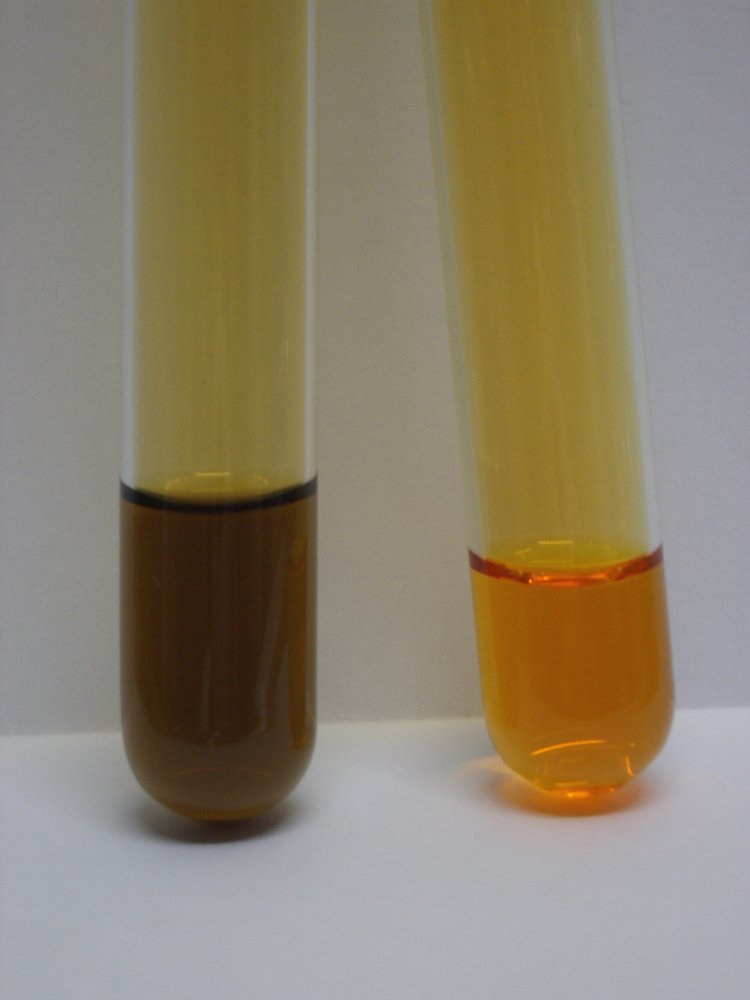 from
an amount
of potassium bromide, which is comparable to the amount,
which is present in the other test tubes. The
picture shows the test tube from the
experiments, described above, with the dilute acid, together with a third test
tube, which contains some bromine water and bromine vapor. The bromine water was
prepared from dilute hydrogen peroxide, to
which a small amount of concentrated hydrochloric acid was added and a small
spatula full of potassium bromide. Heating at 60 C for a few minutes gives the
nice orange bromine-water and the
orange/brown bromine vapor. The contents of the test tube at the right has
nothing to do with the orange liquid, shown in the first pictures. It is a
remarkable coincidence that these two liquids look so similar.
from
an amount
of potassium bromide, which is comparable to the amount,
which is present in the other test tubes. The
picture shows the test tube from the
experiments, described above, with the dilute acid, together with a third test
tube, which contains some bromine water and bromine vapor. The bromine water was
prepared from dilute hydrogen peroxide, to
which a small amount of concentrated hydrochloric acid was added and a small
spatula full of potassium bromide. Heating at 60 C for a few minutes gives the
nice orange bromine-water and the
orange/brown bromine vapor. The contents of the test tube at the right has
nothing to do with the orange liquid, shown in the first pictures. It is a
remarkable coincidence that these two liquids look so similar.
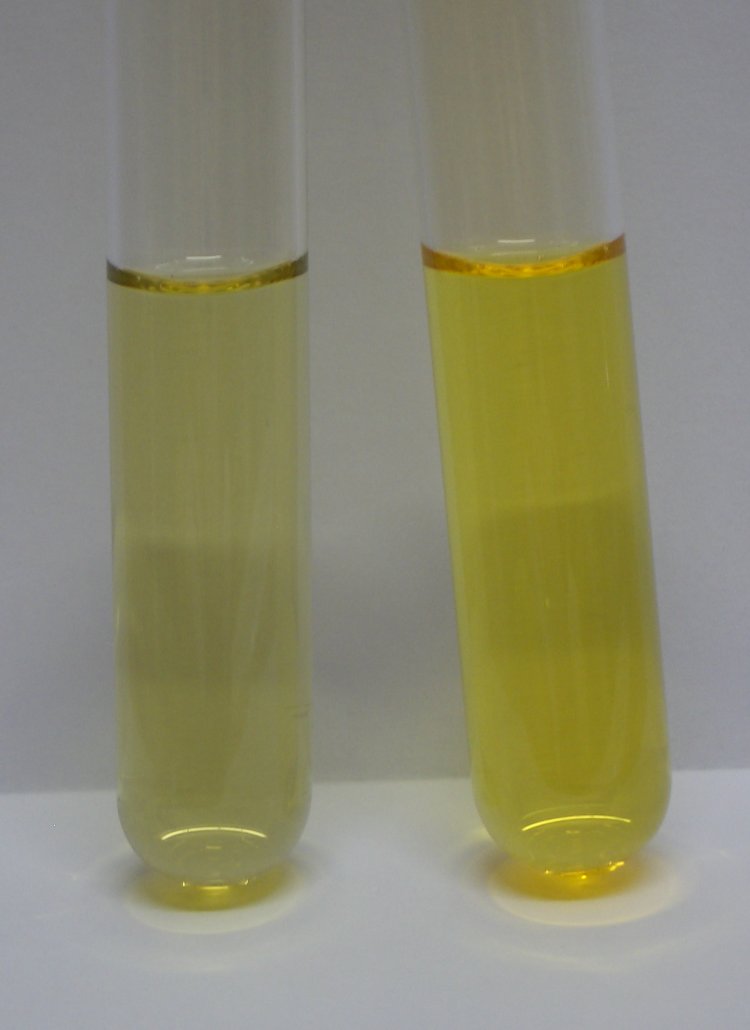 The
final step taken is to dilute both liquids. The dark brown liquid is diluted a
little bit more than two times and the bromine water is diluted more than
three times. The left test tube contains the diluted
dark brown liquid and the right test tube contains the diluted bromine water.
Now the contents of the left test tube is lighter than the contents of the right
test tube and it is a little more greenish/brownish. This shows that the dark
brown color definitely is not due to bromine, otherwise the left test tube would
also be darker on dilution, the more, because the dilution factor is lower for
the left test tube and the initial color is darker for the left test tube.
The
final step taken is to dilute both liquids. The dark brown liquid is diluted a
little bit more than two times and the bromine water is diluted more than
three times. The left test tube contains the diluted
dark brown liquid and the right test tube contains the diluted bromine water.
Now the contents of the left test tube is lighter than the contents of the right
test tube and it is a little more greenish/brownish. This shows that the dark
brown color definitely is not due to bromine, otherwise the left test tube would
also be darker on dilution, the more, because the dilution factor is lower for
the left test tube and the initial color is darker for the left test tube.
![]()
Discussion of the results
Literature mentions the existence of a brown gas ClNO. This gas is quite stable, but on contact with water it quickly hydrolyses, forming HCl and HNO2. Literature also mentions the existence of a brown compound BrNO, which is very unstable and is even more prone to hydrolysis than ClNO. These compounds may be formed in the reactions, described here, but more research needs to be done on this topic when one wants to be sure.
Remarks:
Both the orange and the brown unknowns are only stable in solutions of sufficient high concentration. On dilution both of them disappear. This property makes the assumption that these are Cl-NO and Br-NO plausible. Apparently these compounds are more stable and less prone to hydrolysis than literature suggests. Especially the dark brown compound is more stable than expected, because it exists in only 10% HCl with a single spatula of KBr added.
This experiment can also be done with potassium nitrite instead of sodium nitrite. The potassium bromide can be replaced by sodium bromide.
The dark brown compound is also formed, when bromide is added to a solution with sodium nitrite and dilute sulphuric acid. For the dark brown compound the presence of chloride ions in high concentration is not necessary. The orange compound, as shown in the first pictures requires the presence of hydrochloric acid. When the same experiment is repeated with moderately concentrated sulphuric acid (e.g. 30% H2SO4) or nitric acid (e.g. 30% HNO3), then on addition of NaNO2, the liquid only becomes pale blue and some NO and NO2 is formed.